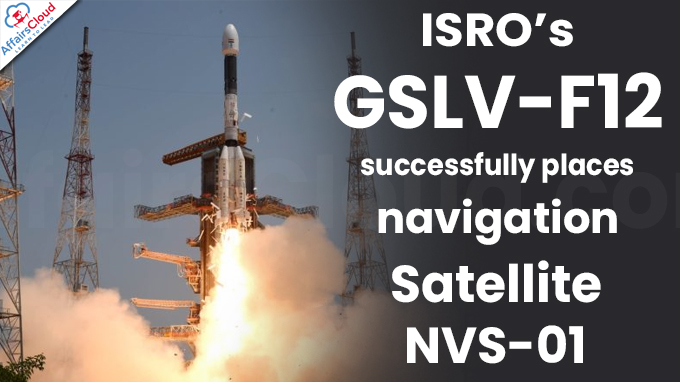 On May 29, 2023, the Indian Space Research Organisation (ISRO) successfully launched the GSLV-F12/NVS-01 mission and placed a second-generation Navigation Satellite, NVS-01, into geosynchronous transfer orbit (GTO).
On May 29, 2023, the Indian Space Research Organisation (ISRO) successfully launched the GSLV-F12/NVS-01 mission and placed a second-generation Navigation Satellite, NVS-01, into geosynchronous transfer orbit (GTO).
- The satellite was carried through a 51.7-metre-tall, 3-stage Geosynchronous Satellite Launch Vehicle (GSLV) rocket with a cryogenic upper stage and lifted off from the Satish Dhawan Space Center(SDSC)-Sriharikota Range(SHAR), Sriharikota, Andhra Pradesh(AP).
- ISRO launched NVS-01 to augment the continuity of Navigation with Indian Constellation (NavIC) services with the launch of the satellite.
Key Points:
i.GSLV rocket deployed the 2,232 kg satellite into the intended GTO at an altitude of about 251 km. NVS-01 carries navigation payloads L1, L5, and S bands.
ii.The satellite is powered by two solar arrays, capable of generating power up to 2.4kW and a lithium-ion battery supporting payload and bus load during the eclipse.
iii.For the first time, the second-generation satellite also carried an indigenously developed rubidium atomic clock, which was developed by the Ahmedabad-based Space Applications Centre. Earlier scientists at ISRO had used an imported atomic clock.
iv.The signals from NavIC are designed to provide user position accuracy to better than 20 metres and timing accuracy better than 50 nanoseconds.
v.NVS-01 is the first in the series of five satellites. The mission life of NVS-01 is expected to be about 12 years. The four more satellite launches are NVS-02 to NVS-05 and the NavIC 2.0 is expected to have around 11 to 12 satellites.
About NavIC System:
i.India has a functional navigational system called the IRNSS (Indian Regional Navigation Satellite System), the operational name was NavIC (Navigation with Indian Constellation).
- It was developed by ISRO to meet the positioning, navigation, and timing requirements of the country, particularly with regard to civil aviation and military requirements over India and the region extending approximately 1500km around the Indian mainland.
ii.The fully deployed NavIC will consist of seven satellite-regional navigation constellations in Geosynchronous/inclined geosynchronous orbits.
iii.Two services such as Standard Position Service (SPS) for civilian users and Restricted Service for strategic users will be offered by it.
iv.NavIC SPS signals are interoperable with the US global navigation satellite system signals, GPS (Global Positioning System), Glonass from Russia, Galileo (European Union), and BeiDou, China.
Note –
This marks the 15th flight of India’s GSLV and the 9th flight with the indigenous Cryo stage. The current launch is the sixth operational flight of the GSLV with an indigenous cryogenic stage.
Recent Related News:
On 22nd April 2023, the Indian Space Research Organisation (ISRO) launched PSLV-C55 with two Singaporean satellites – TeLEOS-2 as the primary satellite and Lumelite-4 as a co-passenger satellite, as a part of the PSLV-C55/TeLEOS-2 mission, from Satish Dhawan Space Center(SDSC)-Sriharikota Range(SHAR), Sriharikota, Andhra Pradesh.
About Indian Space Research Organisation (ISRO):
Chairman– S Somanath
Headquarters– Bengaluru, Karnataka




